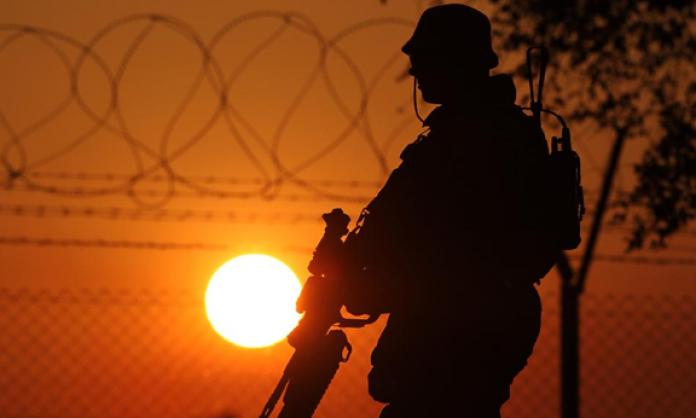Australian troops are being investigated for war crimes in Afghanistan, the ABC has revealed. The investigation, being undertaken by the inspector general of the Defence Forces, is looking into a number of cases of unlawful killing carried out by Australian special forces between 2009 and 2013, details of which are contained in hundreds of military documents leaked to the ABC.
One such incident resulted in the death of a 14-year-old boy, Khan Mohammed, who was shot and killed while collecting figs near his home in Kandahar province in 2012. The boy was unarmed and the patrol had not reported being fired on prior to the killing. The Australian soldiers left the boy’s body where it fell, to be discovered later by locals. They also failed to report the incident to any higher authority.
Another incident under investigation occurred in 2009, when three unarmed men were shot from a helicopter in Jalbay, a village in Uruzgan province. The night time helicopter raid was meant to target a suspected Taliban insurgent, but he could not be located. The men who were killed instead were unarmed and hiding when they were shot. According to intelligence sources, they were civilians, not insurgents.
Another incident involved the killing of an unarmed father and his six-year-old son in 2013 during an SAS-led raid. The troops involved were cleared of wrongdoing because the father, Bismillah Azadi, was deemed to be “almost certainly” a Taliban sympathiser, a claim which his family has denied.
The documents also detail Australian involvement in severing hands of dead Afghans as well as violence and threatening behaviour between serving officers.
Very few of these incidents have been properly investigated before now, reflecting the highly secretive nature of Australia’s operations in Afghanistan. One 2013 incident highlights the culture: a suspected Taliban fighter detained by Australian soldiers was shot and killed in dubious circumstances while waiting to be transported by helicopter to Tarin Kowt, the capital of Uruzgan province.
The commanding officer advised against further investigation into the killing by the Australian Defence Force Investigative Service on the basis that the soldiers would likely refuse to give evidence and could not be compelled. When an investigation was undertaken despite this advice, the soldiers refused to co-operate or hand over evidence, including the weapon used to kill the man.
Speaking on condition of anonymity, one special forces veteran expressed that he had “concerns about a culture of recklessness” within the Defence Force during his service and that troops openly discussed planting weapons on civilians who had been killed in order to protect themselves from scrutiny. He described how he “saw innocent people killed who didn’t need to die or deserve to die in circumstances that were unwarranted and ultimately avoidable”.
Another former Special Operations Task Group member told the ABC that during his time in Afghanistan “the entire concept of operations switch[ed] from ‘clear, hold and build’ to ‘land, kill and leave’”.
The recent leaks are just the latest in a long line of revelations about Australian atrocities in Afghanistan. In 2011, details emerged of the Australian special forces secretive “capture kill” strategy, which resulted in the deaths of dozens of Afghan civilians during botched raids. Australian special forces were further exposed in 2011 for keeping a secret “target list” of people to be assassinated in such operations. Australian troops have also been criticised for backing questionable figures in Uruzgan province where Australian troops have taken a leading role.
Far from garnering the gratitude of locals for their efforts to “liberate” them, Australian troops are, unsurprisingly, widely resented and feared in Afghanistan. Indeed, many of the incidents currently under investigation came to light only because of complaints by locals to the Afghan authorities. These authorities, the very forces which Australian troops are meant to be training and supporting, have received such a quantity of complaints that at times they have refused to work or co-operate with Australian troops because of their reckless brutality.
Anand Gopal, author of the Pulitzer Prize-nominated No Good Men Among the Living: America, the Taliban and War Through Afghan Eyes, told Red Flag:
“The perception that Australian troops are more easygoing is not one shared by Afghans in Uruzgan. There, the Australians are seen as almost identical to the Americans – trigger-happy, willing to kick down doors and terrify families, and supportive of ruthless strongmen. If anything, among communities most wracked by violence, the Dutch are seen as preferable to the Americans and Australians. It was the Australians who, like the Americans, backed the warlord Matiullah Khan to the hilt, even bringing his militiamen to Australia for training.
“It was also the Australians who killed the tribal chief Rozi Khan, possibly because they were duped by a rival strongman – showing how closely they work with these figures, just as the Americans do. In the most violence-affected communities of Uruzgan – like Darefshan, Mehrabad, Surkh Murghab, and Char Chino – the Australians are seen, like the American special forces, as dangerous forces of instability that do not respect civilian life as much as the Dutch.”
Even leaving aside war crimes, the very presence of foreign powers in Afghanistan creates the conditions whereby civilians are in perennial danger. The Western forces have brought into Afghanistan copious quantities of weaponry and money that have helped fuel and raise the stakes in battles between competing interests in the country.
Their failure to establish a central authority with political legitimacy or that can guarantee security creates conditions in which much of the territory outside Kabul is contested, and encourages dubious alliances with strongmen who are willing to do the West’s bidding at whatever cost to Afghan civilians.
Conditions for ordinary people in Afghanistan have deteriorated disastrously as a result, driving many toward the insurgency for political reasons or merely because it offers a means to survive. As Gopal explained to US website SocialistWorker.org:
“The reason why people are fighting in Afghanistan is because they have real grievances regarding violence from US-backed warlords, dispossession, desperate economic circumstances – a whole host of things. And the armed insurgency is what gives expression to those grievances.”
This is the legacy of Australia’s longest running and most expensive military operation ever. The reality of Australian operations – destruction, terror, secrecy and war crimes – deserves to be more widely known and scrutinised. And it should put to rest the spurious image of Australian troops as somehow less arrogant, brutal or imperialist than those of Australia’s more powerful allies.











